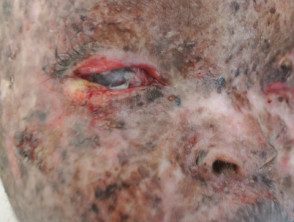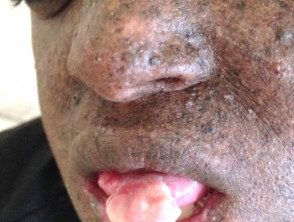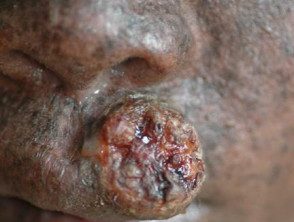What is xeroderma pigmentosum?
Xeroderma pigmentosum (XP) is a very rare skin disorder in which a person is very sensitive to sunlight, has premature aging of the skin, and is prone to developing skin cancers.
Xeroderma pigmentosum is caused by cellular hypersensitivity to ultravioletUV) radiation, as a result of a defect in the DNA repair system. Xeroderma pigmentosum has also been called DeSanctis-Cacchione syndrome.
Xeroderma pigmentosum *

Dry and flaky skin

Tumor on the tongue

Squamous cell carcinoma of upper lip
* Images courtesy of Regional Dermatology Training Center, Tanzania.
See more images of xeroderma pigmentosum.
What Causes Xeroderma Pigmentosum?
Xeroderma pigmentosum is an autosomal recessive inherited disease, which means that a defective xeroderma pigmentosa gene comes from each parent Carriers of the xeroderma pigmentosum trait has one xeroderma pigmentosum gene and one normal gene and shows no signs or symptoms of the disease.
The signs and symptoms of xeroderma pigmentosum are the result of an abnormal nucleotide excision repair system (NER). Two types of NER have been identified:
- Genome (GG) -NER
- Transcription coupling (TC) -NER.
At least seven different genetic abnormalities or complementation groups have been described in different families (XPA to XPG) resulting in variable severity of the disease.
- XPA and XPC are relatively common
- XPE is quite rare
- XPG is serious
- XPF is mild.
In addition to genetic abnormality, the immunosuppressive effects of exposure to Ultraviolet radiation (UV) contribute to disease, for example by depleting Langerhans cells from the epidermis.
Who gets xeroderma pigmentosum?
Couples that are each carrier Xeroderma pigmentosum trait are at increased risk of producing a child with xeroderma pigmentosum. Parents who already have a child with xeroderma pigmentosum have a 1 in 4 chance of having another child with xeroderma pigmentosum.
Xeroderma pigmentosum occurs worldwide and affects men and women of all races. XPA has been shown to be more common in Japan than elsewhere.
What are the symptoms of xeroderma pigmentosum?
The disease generally progresses through 3 stages. The first stage occurs around 6 months after birth (the skin appears normal at birth).
- Areas exposed to the sun, such as the face, show reddening of the skin with climbing and freckles. Irregular dark spots may also begin to appear.
- These skin changes progress towards the neck and lower legs, and in severe cases, towards the trunk.
- During the winter months, these changes can lessen.
Continuous exposure to the sun will lead to the second stage, which is characterized by:
- Poikiloderma
- Skin atrophy
- Telangiectasia
- Mottled hyperpigmentation and hypopigmentation.
The third stage is the development of actinic keratosis and skin cancers. This can happen as early as 4-5 years and an average of 8 years. They are more predominant in sun-exposed areas such as the face. They include:
- Basal cell carcinoma
- Scaly cell carcinoma
- Melanoma.
Eye problems occur in almost 80% of patients with xeroderma pigmentosum.
- The eyes become painfully sensitive to the sun (photophobia)
- Easily irritable, bloodshot and cloudy eyes. Conjunctivitis it can happen.
- Non-cancerous and cancerous growths can occur in the eyes.
Neurological problems occur in approximately 20% of patients with xeroderma pigmentosum.
- These can be mild or severe and include spasticity, poor coordination, developmental delay, deafness, and short stature.
- It can develop in late childhood or adolescence. Once they occur, they tend to get worse over time.
How is xeroderma pigmentosum diagnosed?
Xeroderma pigmentosum is usually found in early childhood, around 1 to 2 years.
A child who develops severe sunburn after their first sun exposure can be a clue to the diagnosis of xeroderma pigmentosum. Xeroderma pigmentosum can usually be conclusively diagnosed by measuring DNA repair factor from skin or blood samples.
What is the treatment for xeroderma pigmentosum?
There is no cure for xeroderma pigmentosum. Gene therapy for xeroderma pigmentosum is still in a hypothetical and investigational stage.
- Family members and known carriers should undergo genetic counseling and avoid consanguineous marriage.
- A fetus at risk for xeroderma pigmentosum may suffer prenatal diagnosis by amniocentesis o chorionic villus sampling and chromosomal failure studies.
The main goal of the treatment is protection against UV rays from the sun and unshielded fluorescent lamps (sun avoidance).
- Outdoor activities should be limited to the night; stay indoors during the day.
- Wear protective clothing (long sleeves and pants, shirts with collars, tight fabrics, wide-brimmed hat).
- Protect your eyes with wrap-around sunglasses that absorb UV rays.
- Apply broad spectrum sunscreens with SPF 50 or higher to all exposed areas.
Patients should have frequent skin examinations by someone who has been taught to recognize the signs of the skin. Cancer. Any suspicious spots or growths should be reported immediately to the doctor.
- Examination by a physician (preferably a dermatologist) at least every 3 to 6 months.
- Actinic keratoses can be treated with cryotherapy or 5-fluorouracil cream. Any suspicious growth must suffer biopsy. Skin cancers are usually removed.
- Frequent eye exams by a ophthalmologist.
- Annual tests (up to age 20) to detect possible neurological problems.
Some patients with patients with xeroderma pigmentosum may be prescribed isotretinoin. This is a derivative of vitamin A that can prevent the formation of new cancers by altering keratinocytes differentiation.
What is the result of xeroderma pigmentosum?
Many patients with xeroderma pigmentosum die at a young age from skin cancer. However, if a person is diagnosed early, does not have severe neurological symptoms or has a mild variant, and takes all precautionary measures to avoid exposure to ultraviolet light, they can survive beyond middle age.
Xeroderma pigmentosum patients and their families will face many challenges in daily life. Constant education and remembering the need to protect yourself from sunlight is essential for the management of xeroderma pigmentosa.

